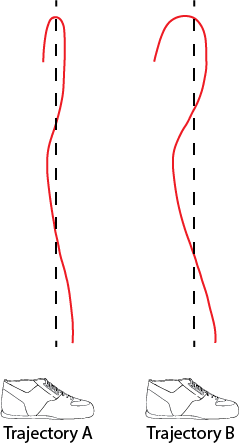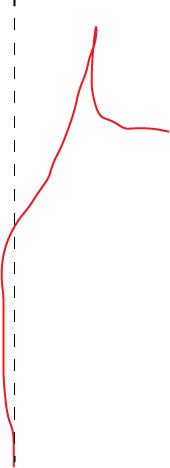Understanding the Pull Trajectory
For those of us who have been around in the sport of weightlifting for 40 years or more, it is incredible to consider that digital video only arrived in the 1990s and what a profound effect it has had on our ability to investigate and understand the movement patterns of athletes in Weightlifting.
These days coaches and athletes in Weightlifting should take every advantage of easily accessible technology to obtain a bar path (trajectory). All that is needed is to capture some video from the side and then import the video file into software such as Kinovea and use the ‘Cross Marker’ tool to trace the bar path. Some familiarity and practice with the software are needed, but the task is quite simple.
The ability to interpret the bar path obtained, however, is dependent on the individual’s understanding of what is an ideal path, and the associated body positions and movement that give rise to bar trajectories, good and not so good. The knowledge needed for such interpretive analysis is gained by self-study not only by viewing countless hundreds of lifts but also by getting to grips with the physics (biomechanics) involved. This article seeks to assist in this regard.
Before we get going, it is important to consider that the displacement (movement) of the bar can be measured vertically and horizontally. Vertical movement is what the athlete in Weightlifting mostly needs but a small degree of horizontal movement is inevitable and even advantageous. The technique of the pull is therefore all about maximising vertical displacement while controlling the degree of horizontal displacement. If there is excessive horizontal displacement of the bar, the athlete is in trouble.
In the illustration above, Trajectory A represents a bar path that is relatively ideal (at least for this author). The trajectory shows a movement of the bar toward the body in the first stage of the pull. In a good starting position, the bar can only be positioned over the front of the foot and not any closer to the middle of the foot due to the limiting factor of the angle of the shins. The initial movement towards the body is helpful to the athlete in two ways. Firstly, the horizontal displacement of the bar toward the body assists the athlete to keep the centre of mass of the barbell over the middle of the foot and thus remain in balance. Secondly, the movement of the bar towards the athlete improves the athlete leverage on the bar. The closer the barbell to the body, the smaller the “weight arm” (see illustration below) and thus the better the mechanical efficiency of the body to lift the weight. It is relatively simple to understand that to hold a heavy weight away from the body is a lot harder than if it is held close.
It is interesting to note that a great many lifters do not achieve any movement of the bar towards the body at the start of the lift. Instead athletes may move the bar vertically upwards or even who move the bar away from the body as depicted by Figure 3. In such circumstances, the centre of mass of the bar drifts to the forward edge of the base and this will have a significant effect on the athlete’s balance and their ability to exert force. In figure 3, the athlete’s bar path is in red, and the blue vertical line depicts the front of the base. In this example the final stages of the pull trajectory are in front of the blue line and this may be attributable to the balance issues created at the start of the pull.
Forward movement of the bar at the start of the pull can largely be prevented if the athlete endeavours to keep pressure on the heels rather than the ball of the foot.
In the second stage of the pull, after the bar has passed the knee, it is nearly always the case that the bar path displays horizontal displacement in a forward direction. As the athlete completes the upward extension of the body, there is movement of the hips towards the bar and with certainty this causes this forward displacement of the bar. The important consideration here is how much forward movement? Commonly, lifters exhibit a pronounced ‘hip drive’ while simultaneously leaning backwards and this gives rise to a ‘swing’ style of pull as depicted by Trajectory B in figure 1 above. In such circumstances there is a significant circular shape to the upper stages of the pull trajectory. The issue here is that the athlete very often has difficulty in fixing the bar overhead due to the tendency of the bar to keep moving backwards as a result of the momentum gained in backward direction.
Coaches therefore in assessing the trajectory of the pull have three important elements to look at:
- The initial stage of the pull (first pull) – is there any movement of the bar towards the athlete?
- The second stage of the pull (second pull) where there is great acceleration of the barbell – is there excessive forward movement (swing).
- The hook at the top of the trajectory – how does the bar descend? If the bar descends very vertically as in Trajectory A above, the athlete will be much more likely to fix the bar overhead. If the hook is very curved as in Trajectory B above, and displays much horizontal movement in rearward direction, the athlete will have greater difficulty in arresting the weight.
Occasionally, we see athletes jumping forward as they move under the bar in the snatch. A movement forward of the athlete will likely be problematic unless the movement is very small. In Figure 4, the athletes forward movement is very significant and is caused by excessive forward thrust of the hips. The illustration shows the forward momentum of the bar and in real life this athlete attempted to save the lift (unsuccessfully) by ducking their head forwards under the bar.
In conclusion, understanding the bar trajectory is very important to the Weightlifting coach. The knowledge helps the coach to understand the causes and consequences of technical errors. Using technology to create bar path helps to demystify technique and to better understand the simple truth that good weightlifting technique maximises displacement in a vertical direction while controlling horizontal displacement. This knowledge helps athletes and coaches to avoid making common errors of technique which when ingrained can be exceptionally hard to fix at a later date by even the best of coaches.
See Kinovea software
[





